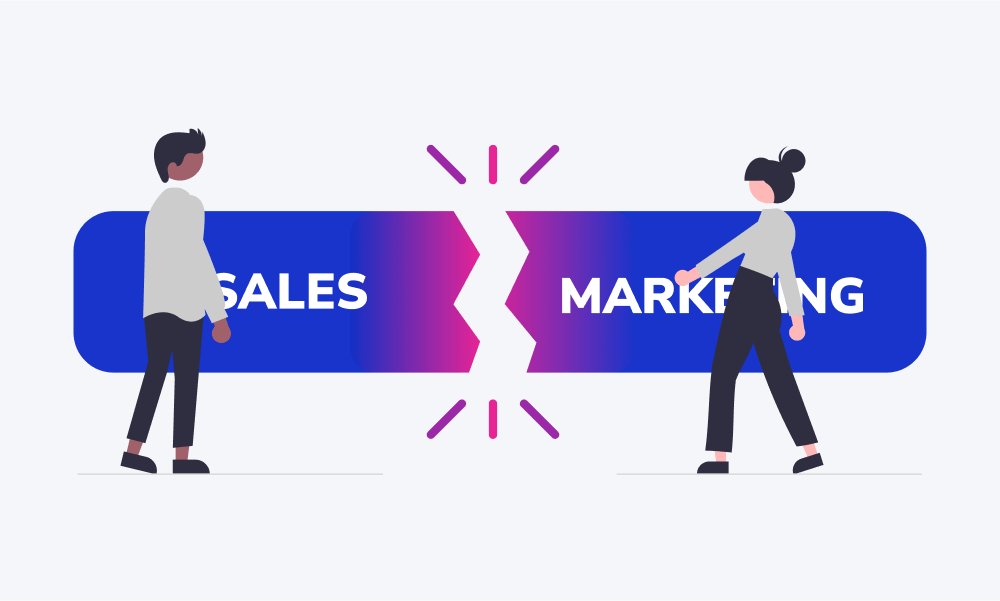Staying ahead of the curve requires more than just a stellar product or service in the competitive realm of B2B sales. It demands a robust, well-orchestrated sales enablement strategy capable of scaling operations to meet market dynamics head-on.
A well-oiled sales enablement mechanism is not just about equipping sales teams with the necessary tools and content; it's about harmonizing the rhythm between marketing and sales, ensuring streamlined onboarding, fostering continuous sales skill development, and leveraging data-driven insights for strategic decision-making.
What you'll learn from this blog:
Harmonize Key Sales Enablement Elements To Scale B2B Sales
As businesses grow, the complexity of sales processes amplifies, and herein lies the value of sales enablement. It's about building a sustainable growth trajectory that's responsive to evolving market demands while ensuring consistency in messaging and quality of customer engagements.
Sales enablement is key to creating sustainable, scalable growth in B2B sales, whether it is integrating the technology stack for real-time insights or cultivating a culture of collaboration among sales teams.
Through the following sections, we'll examine the key components of sales enablement, ranging from content to coaching, demonstrating how each element works together to scale B2B sales.
This guide aims to be your compass in navigating the intricate journey of scaling B2B sales with a solid sales enablement foundation.

Optimize Onboarding for Faster Ramp-Up Time
A well-oiled onboarding machine is the first gear for scaling B2B sales. A structured and efficient onboarding process is quintessential in reducing the ramp-up time, thereby accelerating the path to productivity.
It's not just about familiarizing the new hires with the company culture and expectations but also providing them with a solid foundation of knowledge, skills, and tools necessary for success right out of the gate.
Training and coaching should continue after onboarding is completed. It’s best practice to establish a standardized process for continuously developing the competence of your team. Each rep has unique strengths and weaknesses, so the content of the training and coaching should differ, but the process should be standardized to make sure the team continues to evolve.
|
📖 Sales onboarding is a dedicated process that equips your new sales hires with the necessary knowledge, skills, and behaviors to perform effectively. Get familiar with Mastering Sales Onboarding: The Key to Success in B2B Sales. |
Improve Sales Performance Through Strategic Skill Development
Developing the skills of your sales team is a cornerstone of sales enablement, especially when you’re looking to scale. The sales landscape is ever-evolving, and having a team that’s adept and updated with the latest sales techniques, market trends, and product knowledge is imperative for scaling efforts.
Sales enablement aims to level the playing field for more reps to succeed and bring in more revenue. Increasing the performance of the “low-performing” 80% is an excellent way to scale sales.
According to the Pareto principle, 80% of outcomes come from 20% of causes. When we apply this to sales, it means that 80% of your sales come from 20% of your reps. One-fifth of your sales organization are high-performing sales reps who bring in most of your business.
Sales enablement aims to level the playing field for more reps to succeed and bring in more revenue. Increasing the performance of the “low-performing” 80% is an excellent way to scale sales.
Instead of relying on a few superb salespeople, you should aim for scalable growth through a repeatable process. According to the 80-80 rule, 80% of your revenue should be generated by 80% of your salespeople. The majority of your team should be performing at a high level. This can only be achieved with a repeatable process and standardized skill development needs to be a part of that.
Let’s delve into the essence of continuous learning and the platforms and methodologies that can be harnessed for sales skill enhancement.
How Continuous Learning and Development Can Scale Growth

Improved Performance
Regular training and development translate into improved performance, higher conversion rates, and ultimately, increased revenue. According to CSO Insights, organizations with a well-established coaching program reach 13% higher win rates than those randomly coaching their sales team. Make sure your team is getting the training and coaching they need to shine.
Retention and Motivation
Investing in the growth of your sales team not only enhances retention but also fuels motivation, creating a culture of excellence that’s geared toward scaling.
When you invest in learning and development, it signals to your people that there's a pathway for them to acquire new skills, take on more responsibilities, and advance in their careers. This potential for progression makes people more likely to stay with the company.
Adaptability to Market Fluctuations
Regular training sessions can keep sales teams informed about shifts in the industry, emerging market trends, and competitor movements. Being knowledgeable in these areas allows representatives to position your products more strategically and resonate with current customer pain points.
Continuous learning and development also foster a versatile skill set among sales representatives. As market demands change, reps can quickly pivot, whether that means targeting a new demographic, adapting to a new sales channel, or understanding a new technology.
This adaptability ensures that sales strategies can be modified on the fly to address new growth opportunities.
Platforms and Methodologies for Skill Enhancement
Sales Enablement platforms
Sales Enablement platforms are not just content repositories. They can be used to enable the sales team in multiple ways. A sales enablement platform often works as a one-stop shop for salespeople. They’re onboarded through the platform, and they use it to find, present, and share information throughout the sales cycle, training and coaching can also be supported by the platform.
Learning Management Systems (LMS)
LMS platforms offer structured learning pathways, analytics, and a repository of resources, aiding in the systematic upskilling of the sales force.
Training and Coaching
Arrange recurring training sessions about your products and services to ensure the team has the latest information on your offering. Training sessions should also be organized to address sales-specific skills.
Coaching should always be tailored to the needs of the sales representative. Most likely your reps excel in some areas but need help in others.
The job of the coach is to support the development of the rep. The topics covered in these one-to-one coaching sessions can range from sales tactics to soft skills and career development.
Peer Learning and Mentoring
Peer learning and mentorship provide practical insights and real-world experiences, enriching the learning process and fostering a collaborative culture. Mentorship can be seen as a less formal coaching relationship. Reps may find it easier to gain role-specific knowledge from a mentor who is a senior employee in the same role as them rather than from a manager.
Microlearning
All learning doesn’t have to happen in a structured classroom setting. Microlearning entails short, focused segments of learning designed to meet specific outcomes. It’s effective for quick skill uptake and addressing specific sales challenges.
You could create simple one-pagers, short videos, and other types of easy-to-consume content pieces around different topics. Some could be about your products and services (e.g. battle cards, feature walkthroughs), and others could be about sales skills (e.g. objection handling).
Maintain Trust and Expertise with Consistent Branding
Delivering a consistent brand message across all sales channels is crucial. It upholds the brand’s integrity and ensures clear and uniform communication with prospects and customers, which is pivotal for sales success.
Customer-centric and uniform messaging is especially important if you’re managing a global sales team consisting of both internal sales representatives and external dealers, distributors, and partners. You want to make sure that each rep is delivering the right message. Consistent messaging demonstrates your brand's professionalism and reliability, resulting in increased revenue growth.
Leveraging sales enablement tools can be a game-changer in preserving brand uniformity. These tools provide relevant resources to the sales team, thereby ensuring that the brand message remains consistent throughout the sales process.
Sales enablement platforms often come with features that allow for the centralization and standardization of sales messaging which is crucial for maintaining brand consistency across various channels.
|
💡Sales enablement, at its core, is the process of providing your sales team with the tools, resources, knowledge, and skills they need to engage effectively with prospects and customers. Read more about Discovering Sales Enablement Benefits: Accelerate Sales and Revenue Growth. |
Deliver Content That Resonates At The Right Time
Messaging and content go hand in hand. You want to ensure that your reps are delivering the right message - providing the right content that communicates that message is a no-brainer. The right content delivered at the right time can significantly influence a prospect's decision, making it a crucial component of getting better sales results.
However, having great content is only part of the equation; ensuring its accessibility and effective distribution is what truly empowers sales teams to engage prospects meaningfully.
By investing in the provision of easily accessible, high-quality content, and devising efficient strategies for its organization and distribution, you significantly bolster your sales enablement framework. This, in turn, creates a favorable environment for scaling B2B sales, as well-armed sales teams can engage prospects more effectively, nurturing them through the sales funnel toward a favorable outcome.
A sales enablement platform allows you to centralize, organize, deliver, and analyze your sales content. Use one to make sure your team has instant access to relevant up-to-date material that allows reps to effectively engage with their prospects. Utilize the built-in analytics to see what content resonates with your audience and optimize your content management process to match the needs of your customers at different stages of the buying process.
A sales enablement platform allows you to centralize, organize, deliver, and analyze your sales content.
The process of providing potential customers with the necessary education, guidance, and support to impact their purchasing decisions is often called Buyer Enablement. The goal of Buyer Enablement is to create an environment where the sale is the most logical and beneficial outcome for the buyer.
|
👉 Buyer Enablement focuses on providing prospects with the necessary education, guidance, support and to help them decide before purchasing, which in turn, accelerates the sales cycle. Learn more about What is Buyer Enablement? |
Better Alignment Between Sales and Marketing Teams
Sales and marketing alignment is the process of bringing the sales and marketing teams together under a unified strategy and set of goals. When these two functions work in harmony, they can drive significant growth for an organization.
Sales and marketing alignment can drive revenue growth in many ways - unified messaging, enhanced customer experience, and shared goals can take your sales results to the next level.

3 Aspects of Sales and Marketing Alignment
1. Unified Messaging
A synchronized message across marketing and sales touchpoints presents a cohesive brand image, ensuring clarity and trust in customer interactions. As discussed in a previous section, you want to be consistent in your messaging across all of your sales channels. When your sales and marketing teams are aligned, the messaging is unified not only during the sales process but throughout the entire customer journey.
2. Seamless Customer Journey
Alignment ensures a seamless customer journey from the first marketing interaction to the final sales closure, enhancing the overall customer experience. When your sales and marketing efforts are aligned with each other and in sync with the customer journey, you can expect to reach better results. Organizations that have dynamically aligned their processes to the customer journey reach significantly higher win rates and get better results in quota attainment (CSO Insights, 2019).
3. Shared Goals and Metrics
Establishing shared goals and metrics fosters a collective responsibility toward achieving the organization’s revenue objectives. HubSpot emphasizes this alignment with monthly quotas (Harvard Business Review). Both sales and marketing are expected to hit their number on a monthly basis. In order to achieve scalable sales growth, the sales team needs to get a sufficient amount of quality leads from marketing.
Tactics for Fostering Sales-Marketing Collaboration
Regular Communication and Meetings
Regular interactions between sales and marketing teams promote understanding, transparency, and a collaborative spirit. Regular communication between the teams allows for collective learning and development throughout the revenue team. This leads to better customer understanding and therefore to better customer experience which will boost your sales results.
Integrated Technology Stack
Utilizing a shared technology stack can streamline processes, improve data sharing, and enhance coordination between the two teams. It’s essential that the entire revenue team is using the same technology to some extent.
A sales enablement platform is a good and natural starting point for integrating the tech stack between the teams. In many cases, the sales team uses the platform to present and share material to their prospects. Whereas the marketing team is responsible for providing the said content.
Jointly Developed Content and Campaigns
Co-creating campaigns and content can lead to more relevant and effective marketing materials that resonate well with the target audience. Create a content process that’s based on actual customer needs throughout the buying process. The sales team interacts with prospects first hand and they know exactly what type of material the buyers need at different stages of the process. Collect those requests and co-create the content that’s likely to resonate.
Feedback Loops
Establishing feedback loops for sharing insights, successes, and challenges helps in continuous improvement and better alignment. The sales team could for example share feedback about new sales material that’s been introduced to the sales process. Marketing could share feedback from different campaigns and experiments they’ve been running. Overall the feedback loops and open discussions lead to a better understanding and optimization of all customer-facing activities.
Cross-Training
Cross-training helps in fostering empathy, understanding, and a shared vocabulary between sales and marketing, which is instrumental in enhancing collaboration. Having a better understanding of what each other is doing and why makes it easier to take your revenue processes to the next level.
Shared Performance Dashboards
Having a shared dashboard with key performance indicators keeps both teams aligned on goals and enables real-time progress monitoring. Setting clear SMART sales enablement goals ensures that these KPIs are actionable and measurable, helping teams stay on track. Shared goals and transparent reporting foster a sense of community throughout the revenue team.
Sales and marketing alignment is a crucial element for a unified go-to-market strategy that can significantly propel the scaling of B2B sales. It embodies a collaborative culture that not only enhances internal operations but also positively impacts the customer’s experience, thereby driving growth and sustainability in the competitive B2B landscape.
|
👉 With content at the heart of selling, sales enablement allows marketers to hone the messaging that customers really want to hear and empowers salespeople to hit their stride. Discover What Benefits Does Sales Enablement Bring for Marketing? |
In summary...
As we wrap up this comprehensive guide on scaling B2B sales with sales enablement, one analogy stands out: a symphony. Much like how every instrument in an orchestra contributes to a harmonious melody, each component of sales enablement plays a pivotal role in achieving B2B sales growth.
From streamlined onboarding to continuous skill development, consistent messaging, and delivering the right content, all these facets come together to create a well-coordinated and scalable sales strategy.

The power of sales enablement lies not just in individual elements but in their integration. Aligning marketing and sales, cultivating a culture of continuous learning, and leveraging data-driven insights are all essential in crafting a coherent, effective, and scalable sales approach.
Moreover, ensuring that the sales team is equipped with the right tools, content, and coaching is paramount. Only then can businesses achieve the desired sustainable growth trajectory and remain agile in the face of evolving market demands.
In B2B sales, organizations must remember that sales enablement is a continuous process, not a one-off initiative. It's about staying adaptable, learning from successes and failures, and always striving for excellence. With a robust sales enablement strategy in place, businesses can confidently navigate the complexities of scaling B2B sales and unlock unparalleled growth.
To stay at the forefront of B2B sales, embrace the symphony of sales enablement. Ready to get started with sales enablement? Book a demo with our sales enablement experts or get Showell Free by clicking the banner below. Your organization, your sales team, and your bottom line will undoubtedly thank you for it!
Learn more about Sales Enablement:




.png?width=1000&height=400&name=Blog%20banner_%20Get%20Showell%20Free%20(1).png)
.png?width=1000&height=400&name=Blog%20banner_%20Get%20Free%204%20(1).png)
.png?width=795&height=318&name=Blog%20banner_%20Get%20Free%20(1).png)